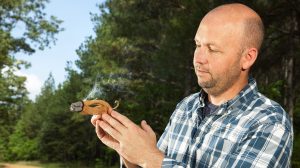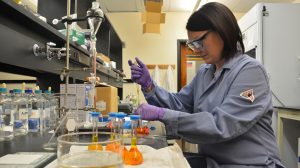
Charles Cantrell, a research chemist with the USDA’s Agricultural Research Service, examines a burning dried male flower from a breadfruit tree, which people in some parts of the world burn to repel mosquitoes and other biting insects. Photo courtesy USDA-ARS photographer Peggy Greb
OXFORD, Miss. – An ongoing partnership between the Natural Products Utilization Research Unit at the U.S. Department of Agriculture and the University of Mississippi’s National Center for Natural Products Research is looking to nature to develop environmentally safe chemicals to manage pests.
The collaboration includes roughly a dozen research projects dedicated to creating natural agrochemicals, such as insecticides, fungicides and herbicides. Charles Cantrell, a research chemist with the USDA’s Agricultural Research Service, works with the NCNPR, a unit of the UM School of Pharmacy, to identify these natural sources that may prove useful as insect repellents.
“There is really a consumer demand for more natural insect repellents that are safer and better for the environment,” Cantrell said.
This partnership began around 2005 when Charles Bryson, an ARS botanist from Stoneville, came to the NCNPR with an idea. He told of how his grandfather would put clippings of American beautyberry, a plant native to Mississippi, in the harnesses of his stock animals while they were in his fields.
The plant repelled horseflies from the animals and repelled mosquitoes from the farmer when he rubbed its crushed leaves onto his skin.
The investigation into this particular remedy led to the discovery of a chemical called callicarpenal that was proven to repel bugs, but was ultimately too expensive for mass production. Since then, the natural products center has actively tested folk and traditional botanical remedies for repelling insects in hopes of finding chemicals that can be made into natural repellents.
“No natural repellent currently on the market is as effective as the two best synthetic repellents, DEET and picaridin,” said Stephen Duke, ARS research leader of the Natural Products Utilization Research Unit. “Finding a highly effective, all-natural insect repellent is important to many members of the public.”
One potential source of natural insect repellent is the breadfruit tree, which is native to Hawaii. The breadfruit flower repels nearby mosquitoes when dried and burned. Scientists from the National Tropical Botanical Garden in Hawaii approached the NCNPR to find out why and how this works.
To begin this study, Cantrell’s team first proved that burning the breadfruit repelled mosquitoes, and then identified the specific fatty acids in the smoke that caused this effect. The lab is working with commercial partners interested in developing these fatty acids into all-natural insect repellents.
Before the product becomes commercially available, Cantrell’s lab or the commercial partner must register the product with the Environmental Protection Agency.

Amber Reichley, a physical science technician in Charles Cantrell’s USDA Natural Products Utilization Research Unit laboratory at the National Center for Natural Products Research, prepares saffron extract for studies aimed at finding natural insect repellents. UM photo by Sydney Slotkin DuPriest
“One of the advantages of the chemicals in the breadfruit is that they can be marketed as natural products,” Cantrell said. “We do create synthetic versions of chemicals sometimes, just to improve their activity, but a lot of companies are looking for all-natural insect repellents.”
Once Cantrell’s lab identifies a potential natural repellent, he sends it to Abbas Ali, a research scientist in the natural products center, who tests the compound to see if it’s effective.
“Our goal is to find a natural alternative to DEET,” Ali said. “We are looking for something that will be safer for children.”
The university recently filed a patent application for a new natural insect repellent and is seeking a development and commercialization partner.
Another insect repellent study in progress at NCNPR uses sweetgrass, a plant native to the northern U.S. and southern Canada. Because the grass has a sweet scent, it is particularly well-suited for a commercial product.
“Local native people would braid the grass and wear it around their neck or store it in their clothing,” Cantrell said. “It gives off just enough of the chemical to repel mosquitoes, and you don’t even have to burn it.”
Not all research projects come from knowledge of traditional practices. Sometimes scientists will gather plants from around the world and conduct random screenings to test them for beneficial chemicals.
Besides finding properties for agrochemicals, these tests can also lead to the discovery of new drugs.
“The Agricultural Research Service has been a great partner of ours,” said Ikhlas Khan, NCNPR director. “One of the benefits of having USDA, NCNPR and the university faculty all in the School of Pharmacy is that discoveries from our combined resources and expertise can benefit multiple areas.”